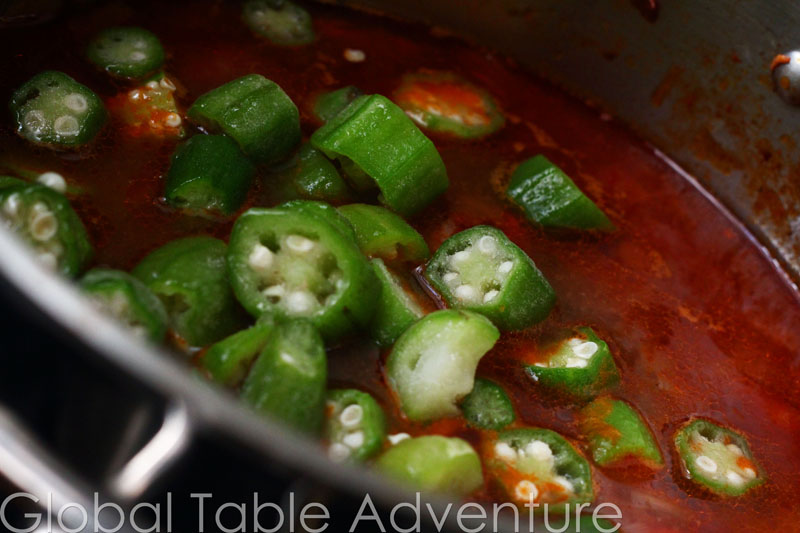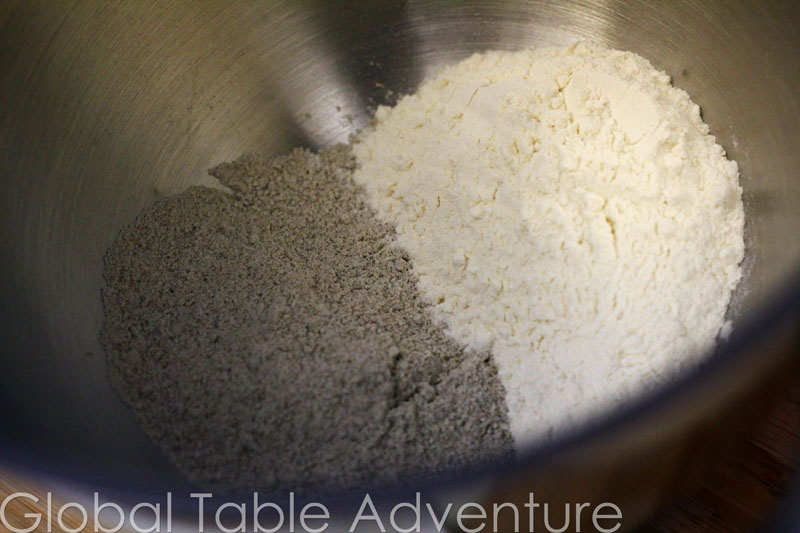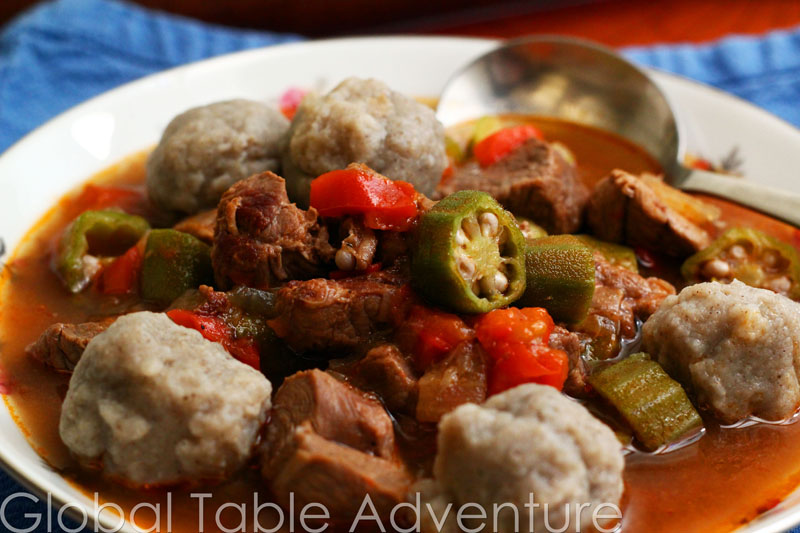Please note: Due to last week’s illness, this meal review covers both Central African Republic & Chad. I’m not sure if anyone’s keeping track, but I haven’t had the best luck with yucca. At this rate, we’ll never be friends. First, there was the Baton de Manioc fiasco- for our Angolan Global Table. That night, after eating several of the batons, I blacked out – lost hearing and sight – crashed to the floor and went into shock. The scariest part? I was holding Ava. Thankfully Keith caught her as she was slipping out of my arms – head first, I might add – and kept her from tumbling down onto the tile. I still get choked up thinking about what could have happened that night. The doctor blamed dehydration, but I’m pretty sure overindulgence in yucca had something to do with it. Second, there was the yucca based sweet, Getuk Lindri – for our Brunei Global Table. Even after doing hours of research I was unable to make a good batch of Getuk Lindri. …
Read More
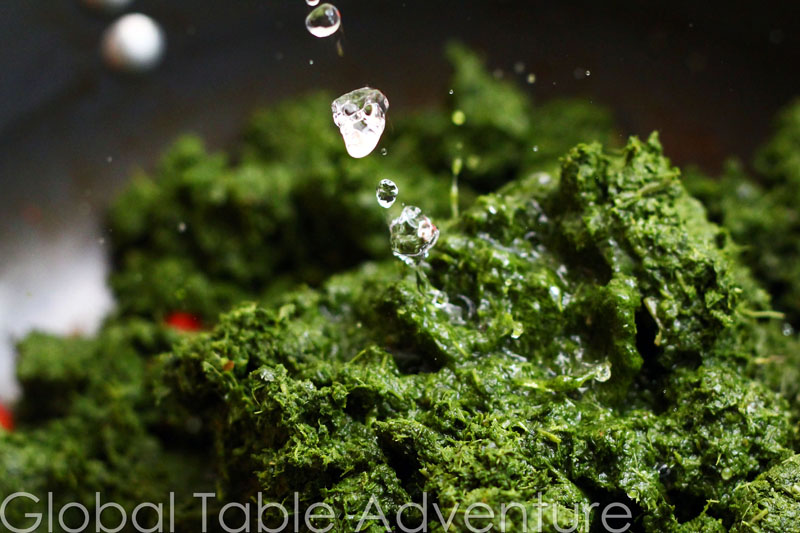
Serves 4-6 Cassava leaves are highly fibrous, dense and grassy. We found ours frozen and “ground” at Ebutte Tropical Market – which saved us a lot of sweat around a mortar and pestle. You could easily double the aromatics in this recipe as the flavors rather get lost behind the domineering cassava. Ingredients: red palm oil 1 large onion, chopped 2 tomatoes, chopped 1 1/2 lbs fresh ground cassava leaves 1 Tbsp peanut butter water salt pepper Method: Thaw out some fresh ground cassava leaves. Over medium heat, cook chopped onion in a drizzle of red palm oil. Note how the oil stains the onions gold. Add tomatoes. And the cassava leaves. The smell will transport you to hay-ville. If such a place exists. Add enough water to keep things moist and sludgey, so that the mixture doesn’t burn. Bring to a simmer. Stir in peanut butter. Stew over low heat, covered, for about 30 minutes. Serve immediately with an Adventurous spirit. Stewed Cassava Leaves Votes: 0 Rating: 0 You: Rate this recipe! Print Recipe …
Read More
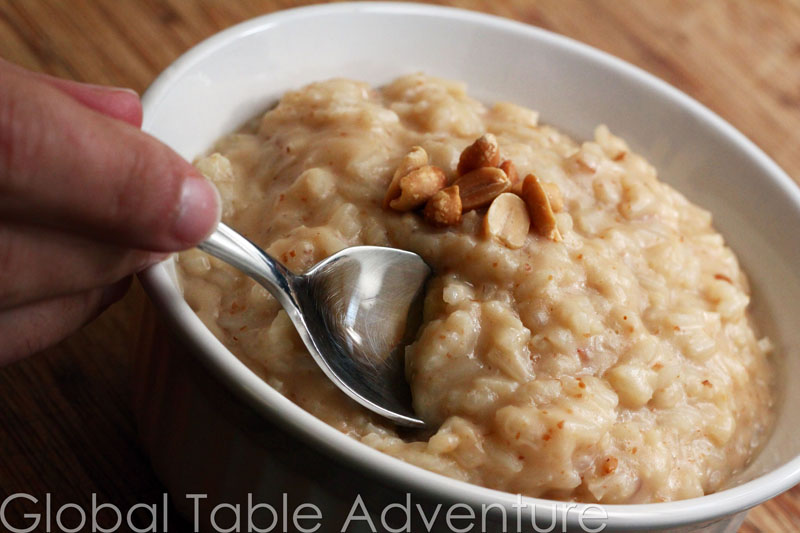
Serves 2-4 If you’re looking for a sweet treat, but the pantry is rather dry, this African peanut butter rice might do the trick. The dish reminds me of peanut butter rice pudding – thick, sweet, and comforting. Ingredients: 1/2 cup white rice 1 1/2 cups water 1/4 cup natural peanut butter 1/4 cup sugar 1/8 cup water additional water, as needed Method: Bring water to boil. Add rice and simmer, uncovered for 15 minutes 2. Meanwhile, mix together peanut butter, sugar, and 1/8 cup water. Natural peanut butter is best because then you can control how sweet your dessert is. I could eat this straight from the bowl. Mmm. When the rice is almost done cooking… … pour peanut butter mixture over rice and stir in. Continue simmering until rice is perfectly tender. Add water as necessary to keep the consistency loose, like rice pudding. Enjoy warm or cold, with a big sweet tooth. Sweet Peanut Butter Rice | Bouiller Votes: 0 Rating: 0 You: Rate this recipe! Print Recipe If you’re looking for …
Read More
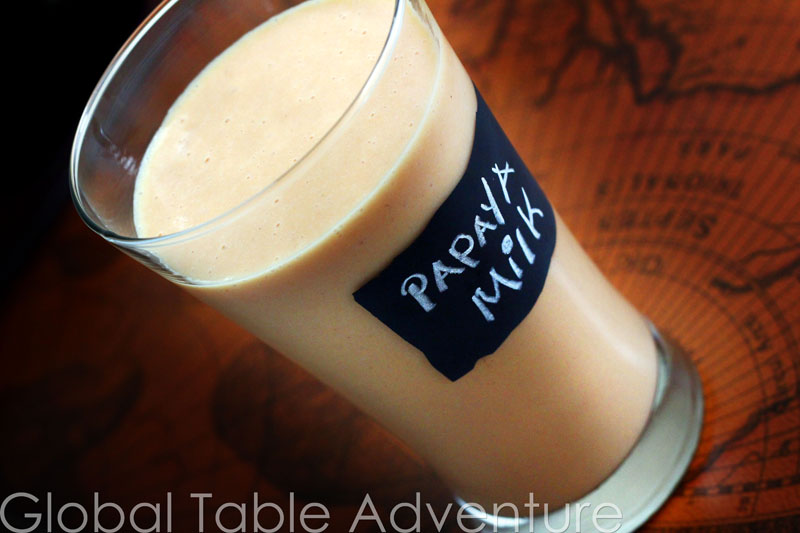
Serves 2 Thick, creamy, and spicy, this drink popular in Northern Chad is refreshing and healthy. Ingredients: 4 cups cubed papaya (if fresh is unavailable you can use 2 cans, drained) 2 cups milk 3 Tbsp sugar 1/4 tsp cardamom pinch ginger 1-2 cups ice, as desired Method: Gather your ingredients. First the beautiful papaya… drained and ready for the blender… Then the spices. Start off with just a little and add the full amount if you can handle it! 🙂 Dump into a blender with some cold milk… And ice, to taste. You can make this drink as thick or as thin as you like. Make it on a wickedly hot day, or a balmy night. Or right this minute. Spiced Papaya Milk Votes: 0 Rating: 0 You: Rate this recipe! Print Recipe Thick, creamy, and spicy, this drink popular in Northern Chad is refreshing and healthy. CourseDrinks, Sweets Lifestyle5-ingredients or less, Vegetarian Food TypeCold Drinks, Fruit, Non-Alcoholic Drinks Servings 2 people Servings 2 people Spiced Papaya Milk Votes: 0 Rating: 0 You: Rate …
Read More
Makes about 2 cups Raw seeds give Egusi sauce grassy flavor and a little bit of texture. The sauce is popular in central Africa, and can be served over vegetables, meats, and fish. Ingredients: 1 small onion 1 tomato 1 chili pepper (I used a poblano from my garden, but you can go as spicy as you want with this recipe) salt red chili powder, to taste 1 1/2 cups ground egusi 1/2 cup water (or as needed) Method: Hunt down some ground melon seeds. I found these at our local African market. Latino stores have pepitas, or pumpkin seeds, which are an acceptable substitute. In a food processor, add tomato… Coarsely chopped onion … And a chili pepper. I left the poblano on the plant long enough that it turned red. The extra time on the plant made it sweeter 🙂 Puree everything together… Add it to a small pot with the egusi… Some salt and pepper… And water… Things don’t look so tasty here… but as the water mixes in, things smooth out. …
Read More
Happy Saturday! Nothing like starting your day off with a little grubworm stew… And here are some images of Central African Republic’s land…
Read More
Hope you have a lovely day! A day in the life of a street corner in Chad: A tourist video (in French): Cooking For Dad’s Images of Chad:
Read More
I bought an apron this summer. It was time to face facts. I’m 31 years old, I’m a mess in the kitchen, and I’m not getting any cleaner. Flour is probably my only regular fashion accessory (although I do love necklaces). In addition, flour is almost always my only chance at “makeup.” As I twirl through the kitchen, I regularly dust flour on my nose, through my hair, and – yes – even on poor little Ava. She’s really a good sport though – she hardly ever notices. So, in honor of flour’s persistent role in my life, let’s talk … flour. This photo shows millet and all-purpose, wheat flour. Around the world, people use all sorts of flour in their food, depending on access to native plants, special diets, and basic needs. In Africa, the most common are flours are Millet, Cassava, Tapioca, Teff, and wheat. In day to day life, flour is typically used to make one of the following items: porridge thick and starchy fufu dumplings fried beignets/doughnuts About flour in this …
Read More
Serves 2-3 Amazingly enough, Keith had never had lamb before we embarked on our Adventure to eat food from around the world. This stew is so fresh and flavorful it won him over immediately. Serve with millet balls. The key to making good lamb stew is to simmer -never boil – the meat. For the first hour the meat will seem tough and chewy but, incredibly, in the second hour even the toughest cut softens, tenderizes and gets that “melt in your mouth” quality that makes stew completely irresistible. Ingredients: vegetable oil 1 1/2 lb lamb, cubed 1 large onion, chopped 1 bell pepper, cut into strips 1 tsp paprika 1 Tbsp tomato paste 4 cups water, or as needed 1/2 lb chopped okra Method: Heat a little oil in a medium pot. Brown lamb – do not crowd. Brown in small batches if needed. When done, return all the meat to the pot and crank the heat to get things moving. Add onion, bell pepper, paprika and tomato paste. I emptied out my paprika jar …
Read More
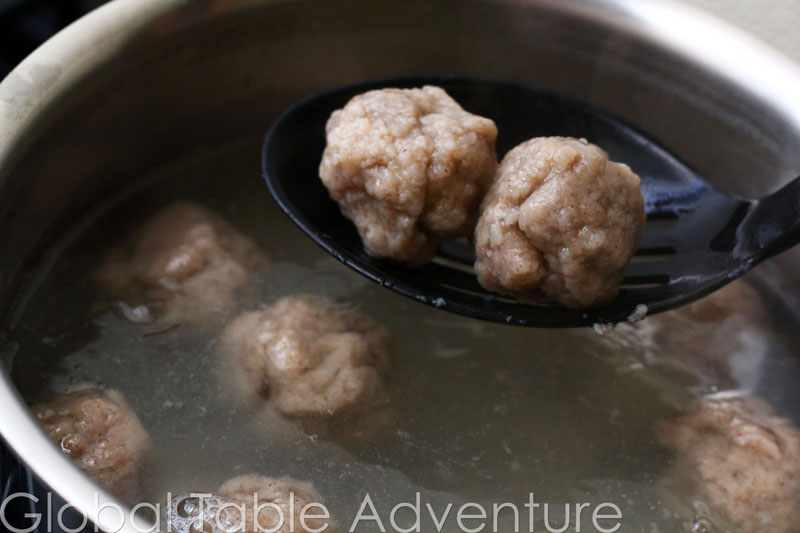
Serves 2-3 Millet flour tastes like wheat flour on steroids. These dense, rather pasty balls are traditional in parts of Africa, particularly central and eastern. They add body and substance to any number of stews and sauces. Ingredients: 1/2 cup flour 1/2 cup millet flour (available at some health food stores and African markets) 1/2 cup water Method: Combine all ingredients in the top of a double boiler. Once everything is mixed together, it will be pasty and sticky. Cover and cook over double boiler for about 30 minutes, or until it looks somewhat dried out, but still pasty and sticky. Meanwhile, bring a pot of salted water to boil. Drop in balls of dough and simmer until they float, about ten minutes. They’ll be dense – perfect filler for a hungry tummy. Serve with sauces or stews, like this Lamb Stew from Chad. Millet Balls for Sauces & Stews Votes: 0 Rating: 0 You: Rate this recipe! Print Recipe Millet flour tastes like wheat flour on steroids. These dense, rather pasty balls are traditional …
Read More

This week we’re eating a double feast from two neighboring countries – Central African Republic and Chad. I had a lot of time to ponder our menu, as there is little else to do while tossing in feverish delirium. Thank goodness we have a good African market in Tulsa, where I can find casssava leaves and ground melon seeds… and really explore the flavors of Africa. CENTRAL AFRICAN REPUBLIC Stewed Cassava Leaves [Recipe] Dark green leaves from the cassava plant stewed with tomato, onion, and peanut butter. Egusi Sauce [Recipe] Ground melon seeds cooked into a sauce with onion, tomato, and chili pepper. We served it with grilled chicken, but this sauce can be served over rice, vegetables, or other meats. Sweet Peanut Butter Rice (Bouiller) [Recipe] White rice sweetened with sugar and natural peanut butter. CHAD Lamb Stew with Okra [Recipe] Pieces of lamb slowly simmered with onion, bell pepper, and okra. Millet Balls [Recipe] A blend of white and millet flour cooked in a double boiler, then formed into balls and simmered. Spiced …
Read More

What a difference a few miles can make. Chad is divided into three main geographic zones – steamy Sahara dessert in the north, the central Savannah, and semi-tropical south. As the landscape changes, so too does the diet. From the north, to the south, very few cultural similarities connect the people of Chad. Northern Chad In northern Chad the people enjoy a diet rich in meat, particularly lamb. Savory pieces of meat might be grilled or stewed with vegetables, such as okra, peppers, onions, and tomatoes (recipe). Many dishes in the north are prepared with yogurt, butter, and milk. In fact, milk stands line the streets in Northern Chad – where busy shopkeepers blend tropical fruits like papaya and mango with milk, into refreshing beverages (recipe). Southern Chad Central and Southern Chad enjoy great quantities of fish, thanks to the plentiful waters of Lake Chad and the Chari River. Meat is not readily available and, with less emphasis on dairy products, lemonade stands dot the countryside instead of milk stands. General Food & Drink A …
Read More

